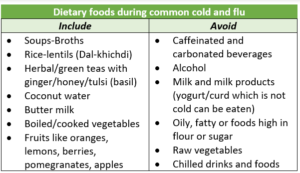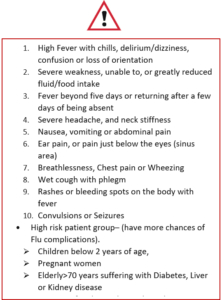Common Cold versus Flu
The common cold and the flu (also called seasonal flu) are both viral infections and have some common signs and symptoms but the viruses causing them, their presentation and the intensity of the illness are different. Many respiratory viruses (like rhinovirus, coronavirus, RSV, HMPV, adenovirus) can cause common cold as well as flu-like symptoms.



Treatment for both conditions is symptomatic.
For the common cold, home remedies are usually enough like warm fluids, steam, and avoiding AC. Medicines are usually not required, however, a whole lot of cold syrups and tablets are available in the market. Medicines for the common cold are helpful if symptoms like stuffiness of the nose and irritating cough are preventing sleep, or if there is a low-grade fever.
For flu, medicines to lower fever and reduce aches/pain are usually given.
Antibiotics are not required unless there is an associated infection of the ear, sinus or throat (pharyngitis), which can occur with flu as well as common colds, or if a lung Infection (pneumonia) develops as a complication of flu. Specific anti-influenza drugs like oseltamivir, zanamivir, baloxavir and favipiravir are approved and used in several countries. They are reserved for cases needing hospitalization, those who develop complications, and if there is an associated condition of compromised immunity.



Common Cold versus Allergic Cold
Sometimes an allergen or irritant in the environment can also trigger symptoms of sneezing and running or stuffy nose which may be difficult to differentiate from the common cold caused by a viral infection.
Allergic colds usually have a much more prominent component of red-itchy eyes and nose, and are usually not associated with sore throat, headache, or weakness. But usually, both are treated similarly and symptomatically. (However, recurrent allergic colds, maybe a sign of a condition called allergic rhinitis, which may need long term antiallergic therapy with nasal sprays/tablets).
Flu versus Swine Flu
There are 3 types of Influenza virus (flu virus) – type A, B, and C. While A and C affect humans and pigs (A also affects birds, horses), type B affects only humans. Type A is the most infective and damaging virus, known to cause seasonal flu epidemics and pandemics (simultaneous epidemics in several parts of the world). H1N1 (also called swine flu as it also affects pigs) and H3N2 are kinds of the type-A flu viruses that causes seasonal flu. Type B is milder, and can cause seasonal epidemics affecting more of high risk and elderly people. Type C is rare, much milder, non-seasonal and does not cause epidemics.
Symptoms of flu include cough, body-ache, headache, high fever, sometimes chills, and weakness that can occur in varying degrees of severity. Flu is self limiting with spontaneous recovery in most cases in 5-10 days, however it can occasionally lead to complications like pneumonia and severe acute respiratory illness (SARI).
The H1N1 virus is a very aggressive flu virus with a higher rate of complications like pneumonia (leading to breathlessness) as well as sepsis (spreading of infection throughout the body), dehydration, and failure of multiple organs (like lung, kidney or heart) leading to fatalities. The swine flu pandemic was seen in 2009. The H3N2 can be more severe in children and elderly. It is being seen currently to be causing seasonal flu in some countries like India in early 2023.
Flu Vaccine
Most children are now given the preventive flu vaccine. Patients in high-risk groups or who have preexisting conditions like asthma, chronic bronchitis (COPD), heart, liver or kidney disease, or known causes of low immunity, are more at risk for chest infections complicating flu, therefore, should be given the flu vaccine. The flu vaccine is given annually before the known flu season of the particular geographical area.
The flu vaccine consists of the 2 most common Influenza viruses – type-A virus (H1NI and H3N2) and the common type-B virus types (Yamagata/Victoria strain). If the flu vaccine has only 1 type-B + 2 type-A viruses, then it is called trivalent and if 2 type-B + 2 type-A viruses are present, then the vaccine is called tetravalent. The virus types change every year due to the constant evolution and mutation of flu viruses.
When should one seek immediate medical help?
Even though the common cold or the flu resolves on its own with symptomatic treatment, complications can sometimes occur. Sometimes ear infection (otitis media) can occur with common cold and flu, and that should be promptly treated.
Other diseases like dengue and malaria can also present with symptoms similar to that of severe flu, like high fever (typical cyclical rise of temperature may be absent in some cases of dengue/malaria), chills, and severe body aches. Therefore, if any of the alert signs below appear, one should visit a doctor immediately-



Sometimes lab blood tests may be required to differentiate flu from dengue and malaria.
Common cold viruses include the rhinovirus (50% cases), common coronavirus (alpha and beta), and the respiratory syncytial virus (RSV). Coronaviruses can also be of the SARS type causing pandemics and epidemics like SARS (Severe Acute Respiratory Syndrome- 2002), MERS (Middle East Respiratory Syndrome) and COVID (2019-22). The symptoms of such coronavirus infections can also resemble those of flu, so these are called ILI (influenza like illness).
Lab tests can differentiate flu from COVID. This should particularly be done if patient is experiencing atypical symptoms, breathlessness (or reduced oxygen in pulse oximetry), or has history of contact with a COVID case.
Other terms used
One may often hear people say, they are down with ‘viral’ by which they usually refer to a common cold or flu.
The doctor may use terms like –
URI/URTI – Upper respiratory tract infection: Refers to common cold or flu, along with ear, sinus and throat infections (pharyngitis)
LRI/LRTI – Lower respiratory tract infection: Refers to infections lower down towards the chest like bronchitis and pneumonia
Further reading –
For any query, additional information or to discuss any case, write to info@drvarsha.com, and be assured of a response soon.
References:


